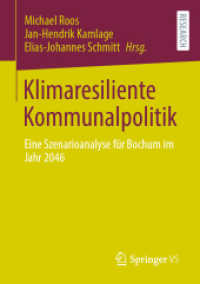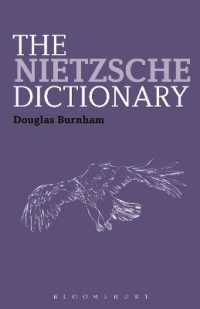- ホーム
- > 洋書
- > 英文書
- > Science / Mathematics
Full Description
Now in a new edition, this book continues to set the standard for teaching readers how to be effective problem solvers, emphasizing the authors's signature methodologies that have taught over a half million students worldwide. This new edition provides a student-friendly approach that emphasizes the relevance of thermodynamics principles to some of the most critical issues of today and coming decades, including a wealth of integrated coverage of energy and the environment, biomedical/bioengineering, as well as emerging technologies. Visualization skills are developed and basic principles demonstrated through a complete set of animations that have been interwoven throughout.
Contents
1 Introduction 1
1.1 A Thermodynamic System and the Control Volume, 2
1.2 Macroscopic versus Microscopic Points of View, 5
1.3 Properties and State of a Substance, 6
1.4 Processes and Cycles, 6
1.5 Units for Mass, Length, Time, and Force, 8
1.6 Specific Volume and Density, 10
1.7 Pressure, 12
1.8 Energy, 18
1.9 Equality of Temperature, 20
1.10 The Zeroth Law of Thermodynamics, 21
1.11 Temperature Scales, 21
1.12 Engineering Applications, 22
Summary, 26
Problems, 28
2 Pure Substance Behavior 35
2.1 The Pure Substance, 36
2.2 The Phase Boundaries, 36
2.3 The P-v-T Surface, 40
2.4 Tables of Thermodynamic Properties, 43
2.5 The Two-Phase States, 45
2.6 The Liquid and Solid States, 47
2.7 The Superheated Vapor States, 48
2.8 The Ideal Gas States, 51
2.9 The Compressibility Factor, 54
2.10 Equations of State, 58
2.11 Computerized Tables, 59
2.12 Engineering Applications, 59
Summary, 63
Problems, 64
3 First Law of Thermodynamics and Energy Equation 71
3.1 The Energy Equation, 71
3.2 The First Law of Thermodynamics, 74
3.3 The Definition of Work, 75
3.4 Work Done at the Moving Boundary of a Simple Compressible System, 80
3.5 Definition of Heat, 87
3.6 Heat Transfer Modes, 88
3.7 Internal Energy—a Thermodynamic Property, 90
3.8 Problem Analysis and Solution Technique, 92
3.9 The Thermodynamic Property Enthalpy, 97
3.10 The Constant-Volume and Constant-Pressure Specific Heats, 100
3.11 The Internal Energy, Enthalpy, and Specific Heat of Ideal Gases, 102
3.12 General Systems That Involve Work, 108
3.13 Conservation of Mass, 110
3.14 Engineering Applications, 112
Summary, 119
Problems, 122
4 Energy Equation for a Control Volume 138
4.1 Conservation of Mass and the Control Volume, 138
4.2 The Energy Equation for a Control Volume, 141
4.3 The Steady-State Process, 143
4.4 Examples of Steady-State Processes, 145
4.5 Multiple Flow Devices, 157
4.6 The Transient Process, 159
4.7 Engineering Applications, 165
Summary, 169
Problems, 172
5 The Classical Second Law of Thermodynamics 186
5.1 Heat Engines and Refrigerators, 186
5.2 The Second Law of Thermodynamics, 192
5.3 The Reversible Process, 195
5.4 Factors That Render Processes Irreversible, 196
5.5 The Carnot Cycle, 199
5.6 Two Propositions Regarding the Efficiency of a Carnot Cycle, 201
5.7 The Thermodynamic Temperature Scale, 202
5.8 The Ideal-Gas Temperature Scale, 203
5.9 Ideal versus Real Machines, 207
5.10 Engineering Applications, 210
Summary, 213
Problems, 215
6 Entropy for a Control Mass 224
6.1 The Inequality of Clausius, 224
6.2 Entropy—a Property of a System, 228
6.3 The Entropy of a Pure Substance, 230
6.4 Entropy Change in Reversible Processes, 232
6.5 The Thermodynamic Property Relation, 237
6.6 Entropy Change of a Solid or Liquid, 238
6.7 Entropy Change of an Ideal Gas, 239
6.8 The Reversible Polytropic Process for an Ideal Gas, 243
6.9 Entropy Change of a Control Mass During an Irreversible Process, 247
6.10 Entropy Generation and the Entropy Equation, 248
6.11 Principle of the Increase of Entropy, 251
6.12 Entropy as a Rate Equation, 254
6.13 Some General Comments about Entropy and Chaos, 258
Summary, 260
Problems, 262
7 Entropy Equation for a Control Volume 274
7.1 The Second Law of Thermodynamics for a Control Volume, 274
7.2 The Steady-State Process and the Transient Process, 276
7.3 The Steady-State Single-Flow Process, 283
7.4 Principle of the Increase of Entropy, 287
7.5 Engineering Applications—Efficiency, 290
7.6 Summary of General Control Volume Analysis, 296
Summary, 297
Problems, 299
8 Exergy 313
8.1 Exergy, Reversible Work, and Irreversibility, 313
8.2 Exergy and Second-Law Efficiency, 324
8.3 Exergy Balance Equation, 332
8.4 Engineering Applications, 337
Summary, 338
Problems, 339
9 Power and Refrigeration Systems—with Phase Change 349
9.1 Introduction to Power Systems, 350
9.2 The Rankine Cycle, 352
9.3 Effect of Pressure and Temperature on the Rankine Cycle, 355
9.4 The Reheat Cycle, 359
9.5 The Regenerative Cycle and Feedwater Heaters, 362
9.6 Deviation of Actual Cycles from Ideal Cycles, 368
9.7 Combined Heat and Power: Other Configurations, 372
9.8 Introduction to Refrigeration Systems, 374
9.9 The Vapor-Compression Refrigeration Cycle, 375
9.10 Working Fluids for Vapor-Compression Refrigeration Systems, 378
9.11 Deviation of the Actual Vapor-Compression Refrigeration Cycle from the Ideal Cycle, 379
9.12 Refrigeration Cycle Configurations, 382
9.13 The Absorption Refrigeration Cycle, 384
Summary, 386
Problems, 387
10 Power and Refrigeration Systems—Gaseous Working Fluids 400
10.1 Air-Standard Power Cycles, 400
10.2 The Brayton Cycle, 401
10.3 The Simple Gas-Turbine Cycle with a Regenerator, 408
10.4 Gas-Turbine Power Cycle Configurations, 411
10.5 The Air-Standard Cycle for Jet Propulsion, 415
10.6 The Air-Standard Refrigeration Cycle, 418
10.7 Reciprocating Engine Power Cycles, 421
10.8 The Otto Cycle, 422
10.9 The Diesel Cycle, 427
10.10 The Stirling Cycle, 430
10.11 The Atkinson and Miller Cycles, 430
10.12 Combined-Cycle Power and Refrigeration Systems, 433
Summary, 435
Problems, 437
11 Ideal Gas Mixtures 448
11.1 General Considerations and Mixtures of Ideal Gases, 448
11.2 A Simplified Model of a Mixture Involving Gases and a Vapor, 456
11.3 The Energy Equation Applied to Gas-Vapor Mixtures, 460
11.4 The Adiabatic Saturation Process, 463
11.5 Engineering Applications—Wet-Bulb and Dry-Bulb Temperatures and the Psychrometric Chart, 465
Summary, 471
Problems, 473
12 Thermodynamic Property Relations 485
12.1 The Clapeyron Equation, 485
12.2 Mathematical Relations for a Homogeneous Phase, 488
12.3 The Maxwell Relations, 490
12.4 Thermodynamic Relations Involving Enthalpy, Internal Energy, and Entropy, 493
12.5 Volume Expansivity and Isothermal and Adiabatic Compressibility, 499
12.6 Real-Gas Behavior and Equations of State, 501
12.7 The Generalized Chart for Changes of Enthalpy at Constant Temperature, 506
12.8 The Generalized Chart for Changes of Entropy at Constant Temperature, 509
12.9 The Property Relation for Mixtures, 513
12.10 Pseudopure Substance Models for Real Gas Mixtures, 516
12.11 Engineering Applications—Thermodynamic Tables, 521
Summary, 524
Problems, 526
13 Combustion 536
13.1 Fuels, 536
13.2 The Combustion Process, 540
13.3 Enthalpy of Formation, 547
13.4 Energy Analysis of Reacting Systems, 550
13.5 Enthalpy and Internal Energy of Combustion; Heat of Reaction, 555
13.6 Adiabatic Flame Temperature, 560
13.7 The Third Law of Thermodynamics and Absolute Entropy, 563
13.8 Second-Law Analysis of Reacting Systems, 564
13.9 Fuel Cells, 569
13.10 Engineering Applications, 573
Summary, 578
Problems, 579
14 Phase and Chemical Equilibrium 591
14.1 Requirements for Equilibrium, 591
14.2 Equilibrium Between Two Phases of a Pure Substance, 593
14.3 Metastable Equilibrium, 597
14.4 Chemical Equilibrium, 598
14.5 Simultaneous Reactions, 608
14.6 Coal Gasification, 612
14.7 Ionization, 612
14.8 Engineering Applications, 615
Summary, 618
Problems, 619
15 Compressible Flow 627
15.1 Stagnation Properties, 627
15.2 The Momentum Equation for a Control Volume, 629
15.3 Forces Acting on a Control Surface, 632
15.4 Adiabatic, One-Dimensional, Steady-State Flow of an Incompressible Fluid through a Nozzle, 634
15.5 Velocity of Sound in an Ideal Gas, 636
15.6 Reversible, Adiabatic, One-Dimensional Flow of an Ideal Gas through a Nozzle, 639
15.7 Mass Flow Rate of an Ideal Gas through an Isentropic Nozzle, 642
15.8 Normal Shock in an Ideal Gas Flowing through a Nozzle, 647
15.9 Nozzle and Diffuser Coefficients, 652
15.10 Nozzles and Orifices as Flow-Measuring Devices, 655
Summary, 659
Problems, 664
Contents of Appendix 671
Appendix A SI Units: Single-State Properties 673
Appendix B SI Units: Thermodynamic Tables 693
Appendix C Ideal Gas Specific Heat 743
Appendix D Equations of State 745
Appendix E Figures 751
Answers to Selected Problems 757
Index 765








